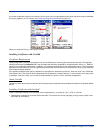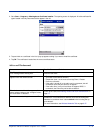
9 - 28 Dolphin® 7900 Series Mobile Computer User’s Guide
Protocol Tab
The Protocol tab enables you to configure parameters that will apply to all the networks the selected port connects to.
Properties
Tap this button to review the properties of a network selected in the list. This button opens the same network
configuration screen as the Add button does; use it to edit network configuration properties.
Field Description
Protocol
Settings
These are the timer intervals and retry settings defined in the 802.1X standard. They determine how long
the supplicant state machine will wait in a given state. These parameters shouldn’t be modified without
an understanding of the supplicant state machine. For more information about the supplicant state
machine, obtain its 802.1X protocol specification.
The parameters are:
• Authentication Timeout - The period of time the Client remains in the authenticating or acquired
state without receiving a response from the AP or switch.
• Held Timeout - The period of time the Client remains in the held state after failing authentication.
• Start Timeout - The period of time the Client remains in the connecting state before restarting when
there is no response.
• Number of Start Attempts - The number of times the Client restarts before giving up. At that point,
the Client then defaults to the authenticated state, but there will be no network connectivity because
the protocol exchange was never completed.
Display EAP
notifications
This option specifies that the EAPOL notification message will be displayed to the user. An authenticator
may use such notification to inform you, for example, about a near password expiration. However, some
authenticators send chatty and annoying notifications that may, for the convenience of the user, be
suppressed. Note that all notifications are written to the event log even if they are not displayed.
Renew IP
address
Select this option to initiate a DHCP request to obtain a dynamic IP address after a successful
authentication, but only if the client detects that the connected network (the SSID) has changed. The
result is that renewal should not occur upon re-authentication, but does occur at boot or when connecting
to a different network. If you have a slow authenticator, you may wish to enable this option when
configuring the service because a slow authenticator may prevent you from getting a DHCP-assigned IP
address upon boot-up. This option is ignored if the given adapter has a static IP address.
Field Description


















